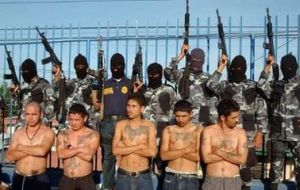MercoPress. South Atlantic News Agency
Crime and violence cost Central American countries 8% of GDP, says World Bank
 Drugs, gang warfare and millions of firearms fuel the situation
Drugs, gang warfare and millions of firearms fuel the situation Growing crime and violence in Central America not only have an immediate human and social toll but they also pose a tremendous threat to development potential in the region since it is estimated that these sources of instability cost 8% of GDP, once health, institutional, private security, and material expenses are accounted for.
According to “Crime and Violence in Central America: A Development Challenge,” a World Bank report, a 10% reduction in homicide rates could boost annual economic growth per capita by as much as one full percentage point of GDP, in those Central American countries with the most homicides.
As it stands now, however, much of the region is headed in the opposite direction. Conditions in some areas of El Salvador, Guatemala and Honduras are so extreme -- with nearly 1 homicides per 1000 inhabitants – they have undermined the prospects of peace and stability that emerged following the resolution of the region‘s civil wars.
Meanwhile in Costa Rica, Nicaragua, and Panama, crime and violence levels are significantly lower, but their steady rise in recent years emerges as a serious concern.
“Public opinion polls show that a large majority of the population in these countries view crime as an unsettling deterrent to their current and future wellbeing,” said Rodrigo Serrano-Berthet, World Bank senior social development specialist and one of the authors of the report.
“Crime and violence also drag down economic growth in significant ways. Aside from the victims’ lost wages and labour, high crime rates harm investment climates and divert scarce government resources to strengthen law enforcement rather than promote economic activity.”
According to the report, these threats weaken key institutions. Existing evidence indicates that drug trafficking increases corruption levels in the criminal justice systems and tarnishes the legitimacy of state institutions in the public mind. Victims of crime, on average, tend to distrust criminal justice systems more. They also approve of taking the law into their own hands and believe less strongly that the rule of law should always be respected.
The report presents a detailed analysis on three main drivers of high crime and violence rates in Central America: drug trafficking, youth violence and gangs, and the widespread availability of firearms.
An estimated 90% of cocaine arriving into the United States travels through the Central America corridor. Drug trafficking is the single main factor behind rising violence levels in the region. ‘Hot spot’ drug trafficking areas have crime rates more than 100 percent higher than ‘non-hot spot’ areas.
There are more than 900 gangs or maras in Central America today, with some 70,000 members. Men age 15-34 comprise most of their membership and account for the overwhelming majority of homicide victims. Still, while gangs are doubtless a contributor to crime in El Salvador, Guatemala, and Honduras, multiple sources suggest only about 15% of homicides are gang-related.
Lengthy civil wars, and increases of imported firearms in the years since, have left Central America awash in weapons. Separate studies indicated about 4.5 million small arms were in the region in 2007—the vast majority of them illegal. All Central American countries have legislation to control gun ownership; still implementation and enforcement remain poor.




Top Comments
Disclaimer & comment rules-

Read all commentsPerhaps more is needed to crack down on crooked politicians big and small, then perhaps they may save money, as well as reducing crime figures , just a thought .
Apr 11th, 2011 - 09:47 pm 0Commenting for this story is now closed.
If you have a Facebook account, become a fan and comment on our Facebook Page!